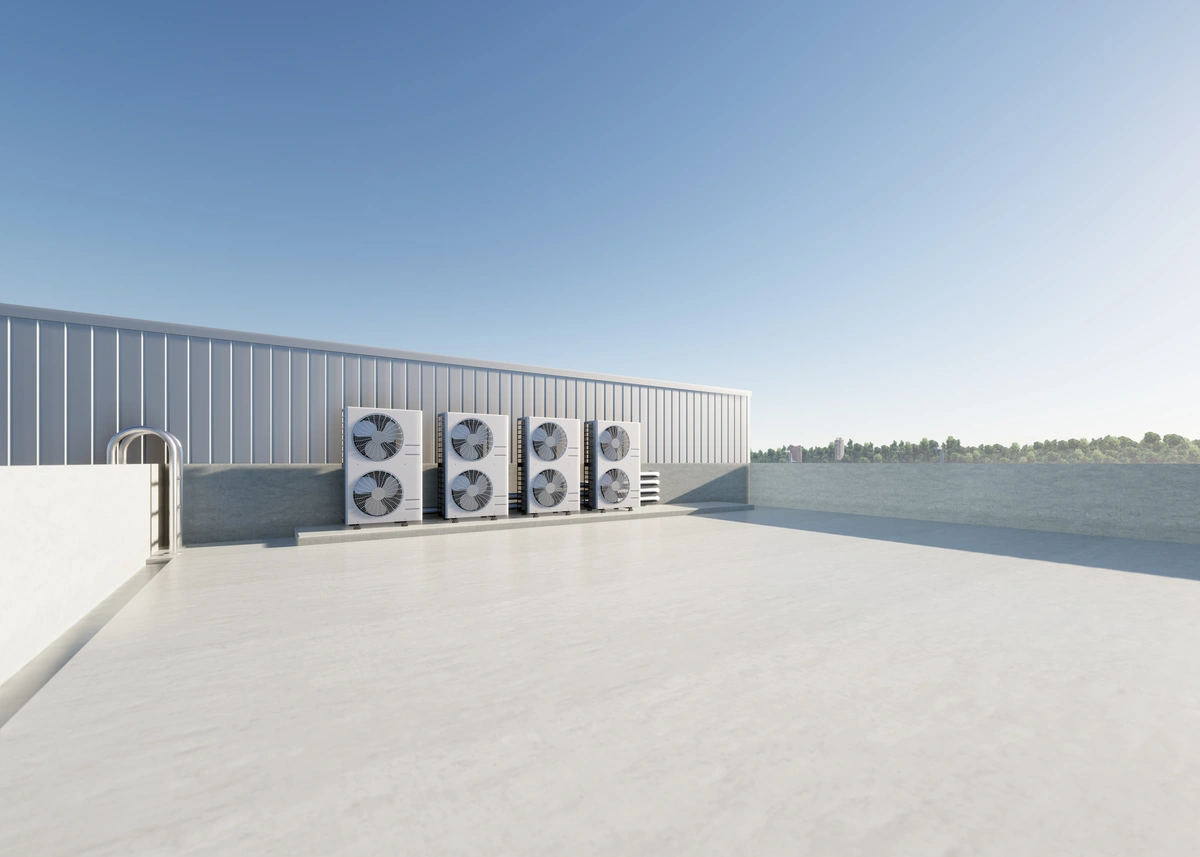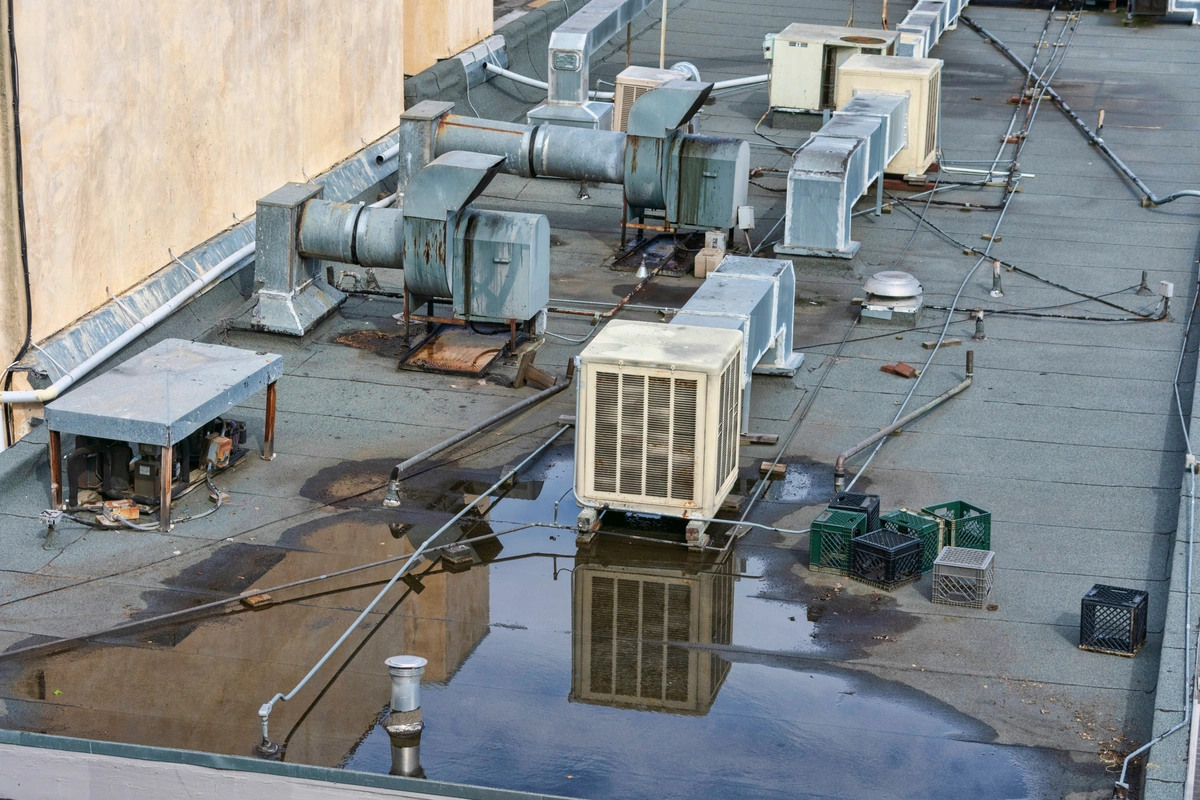Commercial buildings are the backbone of many businesses, providing a space for operations, employees, and customers. However, one aspect often overlooked until it becomes a problem is the roof.
A sturdy, well-maintained roof is essential for the safety and security of:
- Your business 🏢
- Employees 🙋🏽
- Assets 🗂️
In this guide, we’ll delve into the intricacies of commercial roof repair, from understanding what makes commercial roofing unique to recognizing signs of damage, knowing when to call a professional, the repair process, maintenance tips, and when it’s time for a full roof replacement.
What Makes Commercial Roofing Unique
Commercial roofing differs significantly from residential roofing due to several factors:
- Size and Complexity: Commercial roofs are typically larger and more complex than residential roofs, often featuring multiple levels, HVAC systems, vents, and skylights.
- Material Variety: Commercial roofs can be constructed using various materials, including single-ply membranes (such as TPO and EPDM), built-up roofing (BUR), metal, and modified bitumen.
- Foot Traffic: Unlike residential roofs, commercial roofs may experience foot traffic from maintenance workers, HVAC technicians, and other personnel, necessitating durable materials and proper installation.
- Codes and Regulations: Commercial buildings must adhere to specific building codes and regulations, requiring specialized knowledge and expertise during installation and repair.
Signs of Damage
Recognizing signs of damage early can prevent minor issues from escalating into costly repairs or premature roof failure. Common signs of commercial roof damage include:
- Leaks or Water Stains: Water infiltration, visible stains on ceilings or walls, and pooling water on the roof indicate potential leaks or drainage issues.
- Cracks or Blisters: Cracks, blisters, or bubbles on the roof surface may indicate underlying problems with the membrane or substrate.
- Missing or Damaged Flashing: Damaged or missing flashing around roof penetrations, such as vents, chimneys, or HVAC units, can compromise the roof’s integrity.
- Sagging or Uneven Areas: Sagging or uneven sections of the roof may suggest structural issues or water damage within the roofing system.
- Increased Energy Bills: A sudden spike in energy bills could signal insulation problems or air leaks within the roofing system.
When to Call a Commercial Roofing Contractor
While some minor repairs can be tackled by building maintenance staff, certain issues require the expertise of a professional commercial roofing contractor. Consider contacting a contractor if you notice:
- Persistent leaks or water intrusion
- Extensive damage across the roof surface
- Signs of structural issues or compromised safety
- The need for roof inspection or maintenance after severe weather events
- The desire to upgrade or replace an aging roof system
The Repair Process: 6 Steps
Commercial roof repair typically follows a structured process to ensure thorough assessment and effective resolution of issues:
1) Inspection:
A professional roofing contractor conducts a comprehensive inspection to identify areas of damage, leaks, or potential issues.
2) Assessment and Diagnosis:
The contractor evaluates the extent of damage, determines the underlying cause, and recommends appropriate repair solutions.
3) Repair Plan:
Based on the assessment, the contractor develops a detailed repair plan outlining materials, techniques, and timelines.
4) Repair Execution:
Trained technicians execute the repairs following industry best practices and manufacturer guidelines.
5) Quality Assurance:
Upon completion, the contractor conducts quality checks to ensure the repairs meet safety and performance standards.
6) Maintenance Recommendations:
The contractor may provide maintenance tips or schedule follow-up inspections to prolong the roof’s lifespan and prevent future issues.
How to Maintain Your Commercial Roof
Regular maintenance is essential for preserving the integrity and longevity of your commercial roof. Follow these maintenance tips to keep your roof in optimal condition:
🗓️ Scheduled Inspections:
Conduct routine inspections at least twice a year, ideally in the spring and fall, to identify and address any issues promptly.
🧹 Clear Debris:
Remove debris, such as leaves, branches, and dirt, from the roof surface and gutters to prevent water pooling and drainage problems.
🌳 Address Vegetation:
Trim overhanging branches and vegetation near the roof to minimize the risk of damage from falling limbs or plant growth.
🔍 Check Seals and Flashing:
Inspect seals, caulking, and flashing around roof penetrations for signs of wear or deterioration, replacing as needed.
🍂 Clean Drains and Downspouts:
Ensure drains and downspouts are clear of debris to facilitate proper water drainage and prevent backups.
🧰 Address Repairs Promptly:
Address any identified issues promptly to prevent minor problems from escalating into major repairs or roof failure.
When to Fully Replace Your Roof
Despite regular maintenance and repairs, there comes a point when roof replacement becomes inevitable. Consider replacing your commercial roof if you encounter:
- Extensive Damage: Severe damage across the roof surface, such as multiple leaks, widespread deterioration, or structural issues, may warrant replacement.
- Age and Wear: As commercial roofs age, they become more susceptible to deterioration, leaks, and decreased performance. Consider replacement for older roofs nearing the end of their lifespan.
- Energy Efficiency: Upgrading to a more energy-efficient roofing system can reduce utility costs and improve indoor comfort, making roof replacement a worthwhile investment.
- Code Compliance: If your current roof does not meet current building codes or regulations, replacement may be necessary to ensure compliance and safety.
- Business Expansion or Renovation: Roof replacement may be necessary to accommodate business expansion, renovations, or changes in building usage.
Work With the Top Commercial Roofing Contractors
Commercial roof repair is a vital aspect of maintaining a safe, functional, and efficient business environment. By understanding the unique challenges of commercial roofing, recognizing signs of damage, knowing when to call a professional, and prioritizing regular maintenance, you can prolong the lifespan of your roof and protect your investment. Whether addressing minor repairs or planning for a full roof replacement, partnering with a reputable commercial roofing contractor ensures quality workmanship and peace of mind for your business. Remember, a well-maintained roof is the first line of defense against the elements, safeguarding your business, employees, and assets for years to come.
Ready for your commercial roof replacement?Contact Trojan Roofing to get started!



